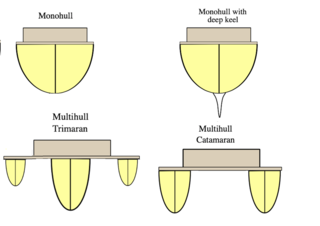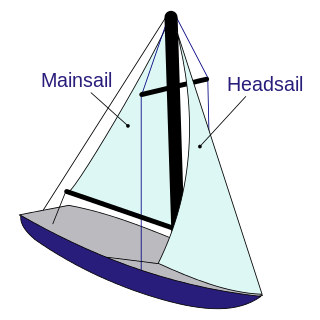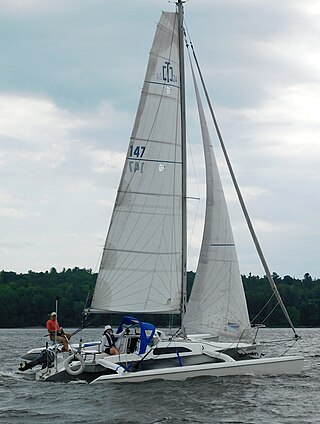
A multihull is a boat or ship with more than one hull, whereas a vessel with a single hull is a monohull. The most common multihulls are catamarans, and trimarans. There are other types, with four or more hulls, but such examples are very rare and tend to be specialised for particular functions.

A sailboat or sailing boat is a boat propelled partly or entirely by sails and is smaller than a sailing ship. Distinctions in what constitutes a sailing boat and ship vary by region and maritime culture.

A catamaran is a watercraft with two parallel hulls of equal size. The distance between a catamaran's hulls imparts resistance to rolling and overturning. Catamarans typically have less hull volume, smaller displacement, and shallower draft (draught) than monohulls of comparable length. The two hulls combined also often have a smaller hydrodynamic resistance than comparable monohulls, requiring less propulsive power from either sails or motors. The catamaran's wider stance on the water can reduce both heeling and wave-induced motion, as compared with a monohull, and can give reduced wakes.

A daggerboard is a retractable centreboard used by various sailing craft. While other types of centreboard may pivot to retract, a daggerboard slides in a casing. The shape of the daggerboard converts the forward motion into a windward lift, countering the leeward push of the sail. The theoretical centre of lateral resistance is on the trailing edge of the daggerboard.

A trimaran is a multihull boat that comprises a main hull and two smaller outrigger hulls which are attached to the main hull with lateral beams. Most modern trimarans are sailing yachts designed for recreation or racing; others are ferries or warships. They originated from the traditional double-outrigger hulls of the Austronesian cultures of Maritime Southeast Asia; particularly in the Philippines and Eastern Indonesia, where it remains the dominant hull design of traditional fishing boats. Double-outriggers are derived from the older catamaran and single-outrigger boat designs.

Hobie Cat is a company that manufactures watercraft and other products as the Hobie Cat Company. "Hobie Cat" can also refer to specific products of the company, notably its sailing catamarans. Its fiberglass catamaran models range in nominal length between 14 feet (4.3 m) and 18 feet (5.5 m). Rotomolded catamaran models range in length between 12 feet (3.7 m) and 17 feet (5.2 m). Other sailing vessels in the Hobie Cat lineup include, monocats, dinghies, and trimarans, ranging in length between 9 feet (2.7 m) and 20 feet (6.1 m). Its largest product was the Hobie 33, 33 feet (10 m) in length. The company's non-sailing product line includes surfboards, kayaks, stand-up paddle boards, pedalboards, eyeware, and e-bikes. It was founded in 1961 by Hobart (Hobie) Alter, who originally manufactured surfboards.

A sailing hydrofoil, hydrofoil sailboat, or hydrosail is a sailboat with wing-like foils mounted under the hull. As the craft increases its speed the hydrofoils lift the hull up and out of the water, greatly reducing wetted area, resulting in decreased drag and increased speed. A sailing hydrofoil can achieve speeds exceeding double and in some cases triple the wind speed.
Corsair Marine International is a sailboat builder that builds trailerable trimarans. Since 1984, Corsair Marine has sold more than 2,500 trimarans. Dealers represent and service Corsair Marine's trimarans in 6 regions of the US and 19 other locations internationally. Currently, Corsair Marine builds 24', 28', 31', and 37' trimarans in different configurations. Since October 2010, the company belongs to the Australian boat builder Seawind Catamarans. The production facility is located in Vietnam.
Farrier Marine is a catamaran and trimaran manufacturer based in Christchurch, New Zealand.

The Farrier F-22 is a New Zealand trailerable trimaran sailboat that was designed by Ian Farrier and first built in 2014.

The F-27 Sport Cruiser is an American trailerable trimaran sailboat that was designed by New Zealander Ian Farrier in 1984–1985.
The Searunner 31 is a trimaran sailboat designed by Jim Brown in the 1960s. It is the most popular boat in the Searunner series, which includes models from 25 ft (7.6 m) to 40 ft (12 m).
The Ocean Bird is a class of trimaran sailboat designed by John Westell and produced by Honnor Marine Ltd. at Totnes, Teignmouth in the 1970s, featuring fold-in lateral floats on a webless steel-beam frame chosen to provide stability against heeling, yet allow a compact footprint in harbour.
The Stiletto 27 is an American trailerable catamaran sailboat that was designed by Bill Higgins and Don Ansley as a racer/cruiser and first built in 1976.
The DC‐14 Phantom is an American catamaran sailing dinghy that was designed by MacLear & Harris and first built in 1964.
The G-Cat 5.0 is an American catamaran sailing dinghy that was designed by Hans Geissler as a one-design racer and first built in 1975.

The Corsair Cruze 970, also called the Corsair 970, is a Vietnamese trailerable sailboat that was designed by the Corsair Design Team as a cruiser and first built in 2012. The boat is a development of the Corsair 31.

The Corsair 24, also called the Corsair F-24, is an American trailerable sailboat that was designed by Ian Farrier as a racer-cruiser. The boat was produced in two versions, the centerboard-equipped Mark I and the daggerboard Mark II.
The Farrier F-24, also called the Corsair F-24, is an American trailerable trimaran that was designed by Ian Farrier as a racer-cruiser and first built in 1991.
The F-24 Sport Cruiser is an American trailerable trimaran that was designed by Ian Farrier as a cruising version of the Farrier F-24. It was first built in 1991.














